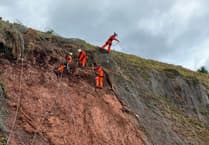Sorry, but I cannot agree with the remarks of Clive Akerman and John French (Review, w/e November 18) in support of the proposed Northern Arc development at Steam Mills/Northern United, nor with their criticism of Ivor Ellis's earlier letter (w/e November 4.) attacking the scheme. As someone who sat on the same side of the table (the "awkward squad"?) as Ivor and other objectors at the recent Examination in Public convened to discuss the Arc plans with the government inspector, I have the greatest respect for Ivor's wealth of experience regarding Forest affairs, and the passion with which he voiced his fears.
As one who also attended many of the HOOF meetings and rallies earlier last winter, and one who will be joining in again should the need arise, I have to differ with Ivor in his views on the latter campaign. But I find myself in very broad agreement with him and with Mike Jones, Keith Morgan and the representatives of the several
conservation and environmental bodies and charities who attended the public hearing.
This proposal is disastrous in what it will do to the surrounding woods and the wildlife and plants, and is nothing less than a brazen attempt to shoehorn a new town into an area of outstanding natural significance, presumably so some well-placed individuals can make a tidy sum out of this destruction, and local politicos and regeneration wonks can preen themselves over their visionariness. Whether Messrs Akerman and French would be quite so equable over the matter should it have been their own leafy milieus of Lydbrook and Brockweir that stood to be affected is a moot point. But I suspect they would not.
The problem with the development is that it's far too large and entirely inappropriate for a woodland setting, it's in entirely the wrong setting (it should be shifted to a genuinely brownfield site elsewhere, preferably on the outskirts of the Forest), and predictably it makes no real concessions to or acknowledgment of the needs of local wildlife and plant species to be left in peace instead of being driven out or exterminated. Yes, there is much talk of "mitigation" (the intention is to move the resident greater crested newts and lesser horseshoe bats to new sites nearby), but newts and bats are protected under current planning law (for how much longer?) and such measures would have had to be put in place anyway. And the new sites do not look anything like as secure and suitable as their existing homes, and no concern at all seems to have been given to the myriad other species whose existence is at threat. Still less is there any awareness of the need for "mitigation" of the behaviour of the people who will be coming to the site to live, work or study . . .
The "problem" with the spine road, even if its intended route is switched to avoid coming too close to the new bat roosts, is that it is still inevitably going to intrude into wildlife and plant habitat areas. The new road will succeed in cutting off and isolating entirely the large block of deciduous and coniferous woodland running northwards from the Northern United pithead to the Nailbridge junction. This woodland will now be surrounded on all sides, effectively encircled by roads and their fast-moving traffic. There are deer and wild boar currently living in this block of forest for much of the time – occasionally they travel east across the Steam Mills road and up into the Edgehills plantation – and their lives and the safety of motorists will both be put at risk. It's worth pointing out that during the on-site visit to the area that concluded the public hearing on the Arc, a large fallow buck clattered out onto the present narrow tarmac road near the pithead, and careered off at speed. So the danger of accidents is clearly a real one. The spine road will be used by many hundreds of vehicles daily – cars, vans and motorbikes belonging to the students and staff of the proposed new college campus, employees at the new workshops and residents of the newbuild estates; vans and lorries delivering to and from Cinderford industrial estate, and tourists travelling in by car, bus or coach. So deer, boar, snakes, lizards, amphibians, small and medium-sized mammals, birds and insects from the surrounding areas are all going to be in peril.
At night, the headlights of vehicles accessing the new road will bounce and re-bounce through the trees around the site and cause more problems and disturbance for wildlife. And it hardly needs stressing that the spine road will become the focus for various forms of antisocial behaviour – a late-night magnet for joyriders and boy racers, drug-takers and -dealers, ravers, poachers and alfresco drinkers and partygoers.
Pretending that the Forest can change and adapt to these problems and still remain the same haven of peace, beauty and tranquillity that we love is fatuous.
Building 175 new houses and flats to
accommodate a new population possibly approaching 700 or 800 on a site like the Arc is equally disastrous and misguided. Apart from the traffic issues and the noise disturbance, there is the obvious likelihood of any wildlife left on those parts of the site not to be built on being adversely affected by some of the new residents entering their supposedly preserved habitat zones. A few years ago the RSPB voiced concerns over the number of new housing estates being built immediately adjacent to protected heathland regions in Dorset and Hampshire. Children from the new houses were wandering into the heather and lighting fires during the dry season, or using catapults and airguns on the birdlife, while cats and dogs were killing groundnesting birds or rare songbirds like the Dartford warbler, and endangered reptiles such as the smooth snake and sand lizard. (Ironically, the nearby army tank and artillery training ranges, even with their frequent manoeuvres using Challenger tanks and live explosions, had no real detrimental effects on their own resident representatives of these rare species!)
Likewise the plans to surround the present angling lake at the Arc site with a new college campus, offices and other workstations, a hotel and bar/pub, biomass plant, visitors' centre and other high-rise and intrusive buildings. Currently the lake is exceptionally beautiful at most times of the year, being girdled with reeds and rushes and overhanging vegetation, and benefiting from a rich variety of attractive deciduous trees forming an outer circle of woodland backdrop to the water.The lake and rushes will remain, of course, but the outer ring of trees will have to be felled en masse to permit all the new constructions to be built. At present the autumn tints and lush spring greenness of these trees is stunning, but when they're gone it will just be the usual utilitarian, semi-Stalinist and permanently ugly "modern" architecture that blights our nation everywhere else. During the on-site visits about 12-15 redwings, newly arrived from the continent to spend the winter with us, were nibbling the fruit on the nearby berry-bearing trees and shrubs, but much of these feeding stations will soon be denied them. And anyone looking down on the site from the heights of the Heywood and Edgehills plantations will be gazing at a three-quarters-of-a-mile-long strip of urban blight comprised of a hellish mass of hundreds of unprepossessing buildings and car roofs, a permanent haze of exhaust fumes, noise, litter and squalor. Progress?
The Forest of Dean District Council's own 'Area Development Framework' carries as one of its planning guidelines that "The lake and the forest are key assets." I'd surmise that a good working definition of a "key asset" would be something you treasure, love, and fight to preserve and protect at all costs. Can't see that they're keeping to their own advice here . . .
The present college campus at Five Acres is set in fine, mature parkland and looks splendid. Some of the classrooms and teaching blocks definitely look past their sell-by date, but it looks well possible to demolish these during term holiday periods and begin to reconstruct them to modern standards. Certainly a "Forest" college continuing to be set pretty much dead-centre in the Dean as a whole is a better advertisement for the area and the college itself than one set amidst noisy industrial estates and on land riddled with old mineshafts and bearing areas contaminated by the industry of the past. I see no reason to relocate the current college to the Arc site. Other than empire-building and careerism on the part of some of the college professionals perhaps. And I would fear the impacts the sudden presence of 1,000-plus young kids will have on the surrounding woods. I foresee late-night "parties" and raves becoming the norm here.
It would be nice (and better) if, as Mr Akerman suggests, we could release much smaller parcels of forest land all across the Dean, so that isolated groups of one or two houses only could be built on them. Much less intrusive and destructive, I agree. But developers are in business for the big bucks, and the latter come from precisely the kind of vast and frequently destructive development the Arc proposals are advocating. This problem is aggravated by the fact that developers strike deals with local councils pledging to build an agreed number of (unprofitable, for them) low-cost social housing so long as they are also permitted to build the much more profitable executive-style dwellings. The latter are of course highly attractive to people seeking to relocate to more rural areas while continuing to travel outwards to and from their places of work elsewhere. Hence we are simply supplying homes for newcomers much of the time, rather than catering for the needs of our own young people. This was tacitly admitted by the district council planning department, who in response to one of my original written submissions to the Arc plans agreed that "People will come to live (in the new houses)". And this is Statutory Forest land we're talking about here, supposedly largely sacrosanct.
The horseshoe bats are to be moved to a pair of "log cabin" structures alarmingly near the main Brierley road and thus vulnerable to late-night vandals (the presence of discarded lager cans and fast-food containers all around this area points up the dangers). At least in their present (brick-built) Northern United site they are safer. The newts are also to be moved to new sites, but these too seem to be much-frequented by "partygoers". At the public examination we learnt from the expert herpetologist Mr Dewsbury of the need for adders (resident on the Arc site) to travel to new areas to find mates (inbreeding produces genetic defects). Newts and lizards also move around a lot (amphibians spend much of their lives on land, not just in the water). But the Arc development would prevent or stymie such freedom of movement, and lead to many of these creatures being crushed on the new road.
Birds will experience disturbances during the nesting season and desert their eggs and young. Butterflies, moths and a vast array of often rare insect species will lose their grassland and tree breeding, feeding and resting sites. Vast numbers of trees will of course need to be felled. Yes, these would be felled anyway in the fullness of time, or simply fall from old age or disease. But this time they won't be replaced, for their places will now be permanently occupied by buildings. Hardly an enlightened attitude to the environment, nor much of a legacy to bequeath to future generations of Foresters.
Yes, the Arc site is "brownfield" land (land formerly built on or used for industry, and thus in planning terms considered OK to develop). But since the claypit days it's been restored and recolonised by nature to an extremely high standard, and it now comprises an area of high amenity value and outstanding scenic beauty. It should be preserved as such, not wrecked for the sake of a quick-snatch profit and a few political or professional careers. At the examination, I suggested to the government inspector that, in between the existing planning categories of "brownfield" and "greenfield" land, we should have a new category: "brownfield land, but worthy of the highest protection", which might perhaps have helped to save the Arc site from its dismal fate. But I'm not holding my breath.
Cinderford at present has quite a few houses going for prices much lower than previously. Surely it would be better to buy them up and employ local builders to renovate them and bring them up to scratch? Otherwise we'll be destroying natural forest and grassland simply so large numbers of in-migrants can turn it into a daytime dormitory town and add to the pressures and hazards on our roads. The politics (and economics) of madness.
– Andrew Stephens.




Comments
This article has no comments yet. Be the first to leave a comment.